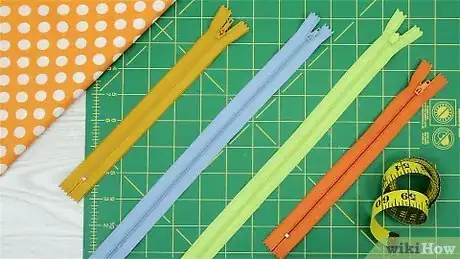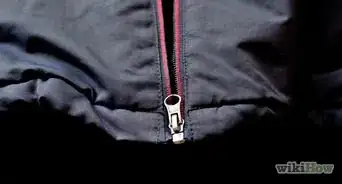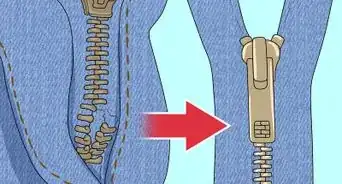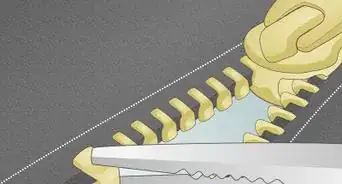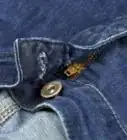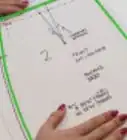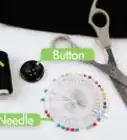This article was co-authored by Kpoene Kofi-Bruce. Kpoene Kofi-Bruce is a tailor, couture wedding gown designer, and the Creative Director of Mignonette Bridal and Ette the Wedding Tailor in Chicago, Illinois. With nearly two decades of experience as a wedding gown designer, small business owner, and vintage sewing enthusiast, Kpoene specializes in wedding gown design and the social history of wedding dresses. She received a BA in Creative Writing from Middlebury College and studied the business of fashion at the Fashion Institute of Technology. She is also a graduate of the Goldman Sachs 10KSB program and the Chicago Fashion Incubator and has written about wedding fashion for Jezebel, Catalyst, the Sun Times, and XO Jane.
This article has been viewed 421,230 times.
Sewing in a zipper may seem like a daunting task for someone just learning to sew. However, while it will take some patience and practice, learning how to do it is worth your time and effort. Being able to sew in a zipper is a very useful skill to have if you want to successfully make your own clothes or other sewing projects that include zippers.
Steps
Preparing to Sew in a Zipper
-
1Purchase a zipper that is the correct size and style for your project. Zippers come in a wide variety of colors, styles, and sizes. Pick the one that works best for your project.
- If you can't find a zipper that is the perfect length, purchase a zipper that is slightly longer than the seam opening you want to put it in.[1] This will give you some leeway in positioning the zipper and will help you avoid hitting the end stop of the zipper with your sewing needle, which would break it.
-
2Pre-wash the zipper to prevent shrinkage. This is only necessary if your zipper is made of natural materials. Simply follow package recommendations, as most zippers are made from man-made materials but some are made from natural fibers such as cotton.Advertisement
-
3Press the fabric sides of the zipper.[2] Make sure it is as flat as possible. Use a gentle heat to prevent melting the zipper if the teeth are made of plastic.
- Zippers with metal teeth can stand up to more heat from an iron.
-
4Cut pieces of fusible lightweight interfacing into one inch strips that are as long as your seam. This is only necessary if you are using a lightweight fabric that is not very strong or stiff. The interfacing will be used to make it stronger and stiffer, better able to handle the repetitive pressure that is caused by a zipper being opened and closed.
-
5Insert the interfacing into the seam area of your project.[3] Simply follow the directions on your fusible interfacing to complete this step. In most cases you will simply place the thin strips of interfacing on the wrong side of your fabric right next to the seam. You will then iron over the fabric and interfacing, which will attach the interfacing to the fabric.
Sewing in a Zipper
-
1Machine baste the zipper opening closed. Sew right along the edge where you eventually want the zipper to be. Remember to sew so that your seam allowances stay the same as the rest of the garment.
- This may seem counterintuitive but remember that a basting stitch is only temporary. It is used here simply to keep your seam in place. You will remove it after you have attached your zipper.
-
2Press the seam open, ironing the seam allowance back against the wrong side of the project.[4] Be sure to get the seam allowance pieces as open and flat as possible, as the folds on either side of the basting stitch will need to be nice and crisp.
-
3Pin your zipper into place. Install the zipper in its closed position. Position the top of the zipper so the pull is just above the top line of the garment.
- Any excess zipper that is laying below the end of the seam is not a problem. You want a little bit extending down, perhaps an inch or so, but any length in excess of that can be removed. Just cut off the excess zipper before you pin the zipper on and whip stitch the end to make a zipper stop.
-
4Machine baste the zipper to your project. Once again, the basting stitch will be removed later, it is just used here to keep the zipper in place. These basting stitches are necessary because they will keep the teeth of the zipper centered on the seam when you can't actually see the zipper as you sew over the right side of the project.
-
5Flip the project over, so that the right side of the fabric is facing up. You should only see the top of the zipper sticking out the top of your project. The rest of the zipper should be hidden away.
-
6Use a zipper foot on your sewing machine to top stitch the seam through all fabric layers. Sew from bottom to top on both sides of the zipper to prevent rippling. The stitches should be kept at close to the center of your seam as possible, but your zipper foot will basically lead the way.[5]
- You will need to finish the sewing by putting a line of stitches across the bottom of the seam. This will give your zipper an end point which the pull cannot go below.
-
7Remove all of the basting stitches with a seam ripper. Begin by taking out the basting stitches that kept the zipper in place. Once those are removed, take out the basting stitches that go down the middle of the seam. This should expose the teeth of your zipper underneath.
- When taking out your basting stitches, be careful not to snag thread in your fabric or any of your permanent top stitches. A seam ripper is a great tool but it can easily cut threads that you don't want it to, so be careful.
-
8Test out your zipper! It should open and close smoothly and be centered nicely in your seam.
Community Q&A
-
QuestionCan I hand sew a new zipper?
 Community AnswerYes, it's possible. Cut the teeth off the old zipper, and sew the new zipper onto the protruding tab from the "toothless" old zipper.
Community AnswerYes, it's possible. Cut the teeth off the old zipper, and sew the new zipper onto the protruding tab from the "toothless" old zipper. -
QuestionHow do I sew a zipper in the middle of fabric if there is no seam?
 Community AnswerAdd a 1/2 inch on both sides of fabric to allow enough fabric for the zipper. It does work even if zipper is supposed to be hidden. Practice on another piece of fabric first. I did this on a nice dress I like, as it had no zipper and I needed a front zipper for easy access, as I am a cancer patient and needed to get my arm in without lifting it. The zipper is hidden into a seam.
Community AnswerAdd a 1/2 inch on both sides of fabric to allow enough fabric for the zipper. It does work even if zipper is supposed to be hidden. Practice on another piece of fabric first. I did this on a nice dress I like, as it had no zipper and I needed a front zipper for easy access, as I am a cancer patient and needed to get my arm in without lifting it. The zipper is hidden into a seam. -
QuestionHow do I prevent the fabric from stretching while sewing in a zipper?
 Community AnswerPin the zipper in the right place to prevent the material from moving and stretching.
Community AnswerPin the zipper in the right place to prevent the material from moving and stretching.
Things You'll Need
- Sewing machine
- Zipper foot
- Zipper
- Scissors
- Pins
- Seam ripper
References
- ↑ https://www.youtube.com/watch?v=Lxvdx7Pb-20
- ↑ http://www.coletterie.com/tutorials-tips-tricks/tutorial-installing-an-invisible-zipper
- ↑ http://www.threadsmagazine.com/item/3728/sewing-in-a-zipper
- ↑ Kpoene Kofi-Bruce. Couture Bridal Designer. Expert Interview. 28 January 2021.
- ↑ Kpoene Kofi-Bruce. Couture Bridal Designer. Expert Interview. 28 January 2021.
- Videos provided by So Sew Easy
About This Article
To sew in a zipper, start by machine basting the zipper opening closed, keeping your seam allowances the same as the rest of the project. Next, press the seam open, ironing the seam allowance against the wrong side. Make sure the zipper is in the closed position, then pin it in place and machine baste it to your project. Use a zipper foot to top stitch the seam through the fabric, remove all of the basting stitches with a seam ripper, and give your new zipper a try. If you want to learn which types of zippers you should use for your project, keep reading the article!
